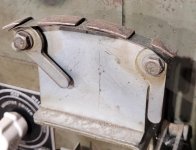Ultradog MN
Cast Iron
- Joined
- Jun 14, 2020
I bought these two blade welders today.
I will keep one, my friend wants the other.
I don't know if they work but for the moment, let's assume they do.
Both are 220V single phase.
There is some info online on the Grob (type RW-B).
It is missing the grinding wheel and guard.
I can fix that.
Didn't find much info on the Boice Crane unit.
No model # on it.
Which one would you guys keep?
Why?
Thanks


I will keep one, my friend wants the other.
I don't know if they work but for the moment, let's assume they do.
Both are 220V single phase.
There is some info online on the Grob (type RW-B).
It is missing the grinding wheel and guard.
I can fix that.
Didn't find much info on the Boice Crane unit.
No model # on it.
Which one would you guys keep?
Why?
Thanks






